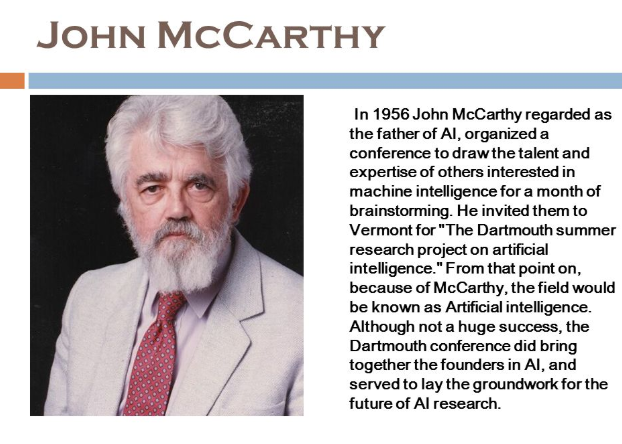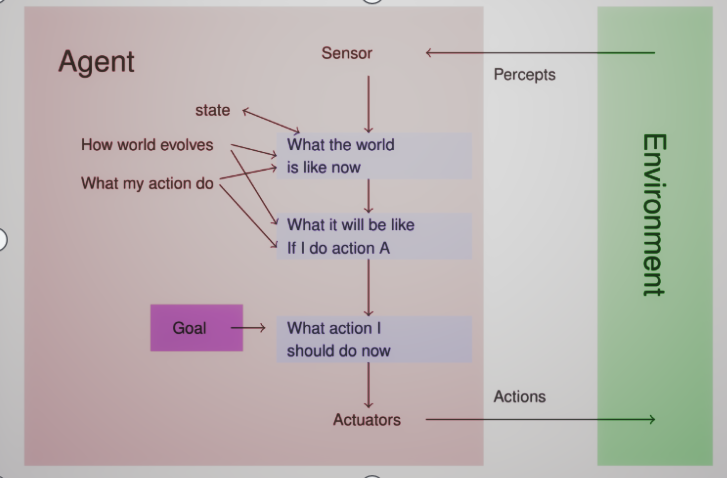The term AI was first coined by John McCarthy in 1956
In 1955 John McCarthy, then a young Assistant Professor of Mathematics at Dartmouth College, decided to organize a group to clarify and develop ideas about thinking machines. He picked the name ‘Artificial Intelligence’ for the new field. He chose the name partly for its neutrality; avoiding a focus on narrow automata theory, and avoiding cybernetics which was heavily focused on analog feedback, as well as him potentially having to accept the assertive Norbert Wiener as guru or having to argue with him

Artificial Intelligence is a fairly involved area, a lot of things come from psychology, philosophy, mathematics, economics, linguistics, biology, and computer engineering. It includes many fields such as a database, information retrieval, statistics, and machine learning.
Types of Learning Systems
Supervised: “right answers” are provided for sufficient training examples. The computer tells “right answers” for new input. Performance measure. (Classification and regression)
Unsupervised: “right answers” are NOT provided and the computer tries to make sense of the data. How good the spread of items is. (clustering and association rule)
Semi-supervised: “right answers” are provided for
Active:
Lazy: learner
Transfer: Learning a task B to do A. (cycle riding for bike riding) Deep: processing like the human brain
Success Stories
Deep Blue of IBM In 1997 beat current chess champion Gary Kasparov 1-Kasparov, 2-DeepBlue, 3-draw
AlphaGo of Alphabet Inc. In March 2016, it beat human professional Go player Lee Sedol in a five-game match by 4/1 https://deepmind.com/research/alphago/
Waymo: A safer driver that is always alert and never distracted First driverless ride on public roads in 2015 giving a ride to a sole blind In public: 2020
German Traffic Sign Recognition Benchmark (GTSRB) 99.46% against 98.84% of human
Google mapped every single location in France in two hour Images acquired from Google street view
Example of an image search That can taking care of color and pose of the object in the image
Vision
In pursuit of computers doing things which at the moment, people do
better, AI attempts to build intelligent entities called Agents 1
Agent perceives the environment through sensors and acts upon the environment through actuators. Our approach is to build a rational agent. How well an agent can behave depends on the nature of

We need a Rational Agent
Rational Agent is one that does the right things with time.
Sequence of actions of agent leads to sequence of states of the
environment.
Note: Rationality is not perfection. Rationality maximizes expected
performance whereas perfection maximizes actual performance.
A performance measure could be used to evaluate how the
sequence of state of environment is desirable (NOT of agent)
Design performance measure according to what one actually
wants in the environment, rather then how agent should behave
What is desired is not easy to define (simple life or ups and down)
(every one in moderate poverty or some rich some more poor).
Omniscient vs Autonomous Agents
Omniscient agent knows actual outcome of its actions (this is
impossible)
An autonomous agent learns to compensate for partial or
incorrect prior knowledge
Agent’s structure can be viewed as −
- Agent = Architecture + Agent Program
- Architecture = the machinery that an agent executes on.
- Agent Program = an implementation of an agent function.
Agent Types
Agents are of basically four types, like Simple Reflex Agent, Model-Based Reflex Agent, Goal-Based and Utility based.

AgentTask environment is described by Performance, Environment,
Actuators, Sensors (PEAS)
Environment
The environment could be Fully Observable vs Partially Observable, Single-agent vs Multiagent, Deterministic vs Stochastic, Episodic vs Sequential, Static vs Dynamic, Discrete vs Continuous, Known vs Unknown
Critic
A General Learning Agent has Critic to determine how the agent is doing, Learning agent to make rules to improve/adapt, and Problem Generator to suggest experiments under different condition.
Some genuinely nice and useful information on this web site, too I conceive the style contains great features.
Im now not sure where you are getting your information, but good topic. I must spend a while learning more or working out more. Thanks for great info I was in search of this information for my mission.